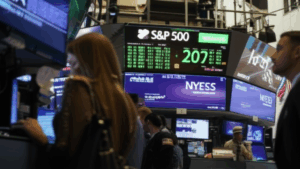Risk Appetite Takes a Hit as Trump’s Tariffs Return to the Spotlight
Global financial markets are once again grappling with a familiar specter: the potential resurgence of aggressive trade tariffs under a possible future Trump administration. The mere discussion of steep new duties, particularly against Chinese goods and potentially extending to European imports, has sent shivers through investor circles, prompting a palpable dip in what’s known as “risk appetite” — the willingness of investors to take on risk in exchange for potential higher returns. This shift away from growth-oriented assets and towards more stable havens underscores a broader anxiety about renewed trade wars and their far-reaching economic implications.
During his previous term, former President Donald Trump’s administration initiated a series of tariffs, most notably against China, on a wide array of goods ranging from steel and aluminum to consumer electronics. These actions sparked a protracted trade war that disrupted global supply chains, increased manufacturing costs, and created significant uncertainty for businesses operating internationally. While some tariffs remained in place, the intensity of the trade conflict had somewhat subsided. Now, as the 2024 U.S. presidential election looms, discussions about potential future tariff policies are intensifying, with some reports indicating consideration of a blanket 60% tariff on all Chinese imports, alongside renewed threats against European Union goods. The rhetoric, often framed as protecting domestic industries and American jobs, is nevertheless perceived by markets as a substantial threat to global economic stability.
The immediate market reaction has been telling. Major stock indices, particularly those with significant exposure to international trade and multinational corporations, have shown heightened volatility. Companies reliant on global supply chains or exporting heavily to targeted regions face the prospect of increased input costs, reduced competitiveness, and diminished profit margins. This directly impacts their valuations and investor confidence. Furthermore, the bond market has seen a “flight to safety,” with investors flocking to U.S. Treasury bonds, pushing their yields down as demand increases. Gold, a traditional safe-haven asset, has also seen renewed interest. Currency markets are also on edge, as trade imbalances and retaliatory measures could lead to significant fluctuations, impacting international transactions and investment flows. Beyond the direct impact on trade, tariffs are inherently inflationary. By raising the cost of imported goods, they can push up consumer prices, eroding purchasing power and potentially forcing central banks to maintain higher interest rates for longer, further dampening economic growth. For young investors building portfolios, this environment means a greater emphasis on diversification and vigilance, as sectors previously deemed stable might become vulnerable, and previously aggressive growth strategies may need re-evaluation. The uncertainty creates a need for agility, as predicting the specific goods or countries that might be targeted, and the severity of the measures, remains speculative until clearer policy outlines emerge.
Looking ahead, the mere threat of extensive tariffs injects a heavy dose of unpredictability into an already complex global economic landscape. The actual implementation of such policies could trigger retaliatory measures from trading partners, escalating into a full-blown trade war that severely hampers global economic growth, strains international relations, and disrupts the delicate balance of supply chains painstakingly rebuilt after recent global crises. While the political rationale for these proposals often centers on domestic benefits, the historical record suggests that protectionist measures carry significant risks, including higher costs for consumers, reduced export opportunities for domestic industries, and a potential drag on overall economic expansion. Investors, especially those new to navigating market cycles, are urged to remain highly informed, as the unfolding political narrative and its potential economic consequences will dictate market sentiment and investment opportunities in the coming months. The return of tariff talks serves as a stark reminder that geopolitical factors remain powerful drivers of financial market dynamics, often outweighing fundamental economic indicators in the short term.





